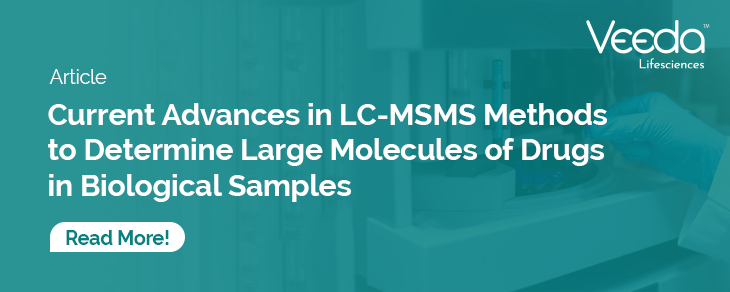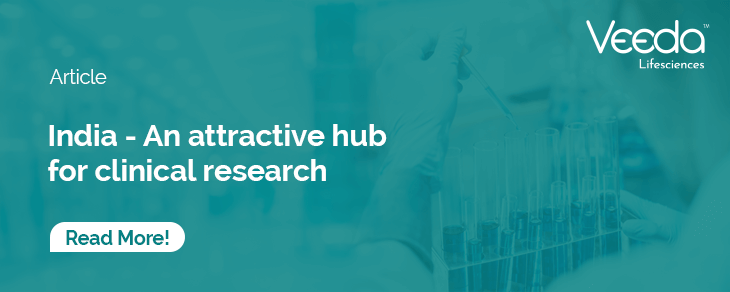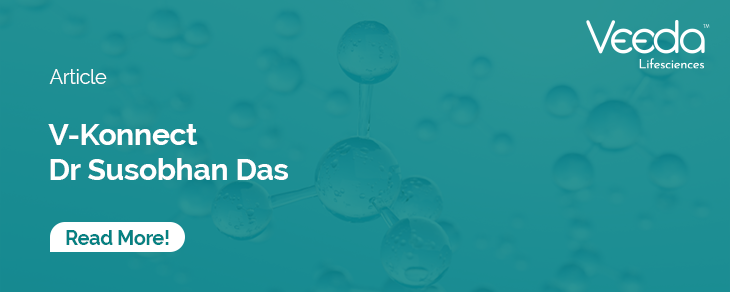Veeda through its V-Konnect series interacted with Dr. Ashok Kumar and discussed about “Current Outlook of Indian Pharmaceutical industry”
About the V- Konnect
V-Konnect interview series, is a program to get in touch with specialized industry experts to know their views on opinions on current relevant subject matters.
About Dr. Ashok Kumar – President, Centre for Research & development at Ipca Laboratories Limited
Dr. Ashok Kumar carried out his Ph.D. work at CDRI, Lucknow under the supervision of Padmashree Dr.Nitya Nand. This was followed by Post-Doctoral studies with Prof. Sir John Cornforth CBE, FRS a Chemistry Nobel Laureate, at the University of Sussex, England from 1981-1984.
He started his carrier with Alchemie Research Centre at ICI, Bombay in 1985 and served Lupin Laboratories before taking up the job with Ipca Laboratories Mumbai, a leading Pharma Company in the year 2000 and is presently heading the Centre for Research & Development of Ipca in the capacity of President.
He is a co-author in more than three dozen papers published in peer reviewed International Journals, co-inventor in more than 150 patent applications filed, has presented scientific papers and keynotes in many National / International Conferences in addition to delivering invited talks on R&D Management, Idea Management, Innovations, Role of Common Sense and Philosophy in Discovery / Research and many more such topics.
Interview Transcript.
1. What are the immediate key priorities for the Indian pharmaceutical industry?
A1: To remain competitive Indian Pharma’s Key priorities should consider the followings:
GMP Regulatory Issues: Strengthening of the regulatory framework and involvement of the relevant automation to at least avoid, if not completely eliminate human errors. Updating the systems may turn out to be costly, but certainly would help in increasing compliance & qualifying US FDA’s needs and expectations.
API Manufacturing: Technological interventions in manufacturing of APIs supported by PAT is likely to make production easy, environmental friendly and cost effective, however, would require development of expertise & mindset. These changes will obviously make API manufacturing more competitive and will also help in reducing our dependence on China to a great extent.
Innovations in API development using intelligent chemistry approach and manufacturing with the help of emerging technologies leading to cost competitiveness is more easy for Indian Pharma companies because it is going to be a mere extension of what we have been doing since long.
2. Is there any one area where you would anticipate growth? How do you see India developing in that area in the coming years?
A2. Though we are yet to discover the way to do something which qualifies under the head ‘Made in India’, India has done reasonably well in providing quality services. Providing economical services to IT sector and being 3rd largest producer & supplier of finished dosage formulations of generic formulations / drugs, across the globe for quite some time, can definitely be considered good examples where India has fared well.
Following service areas, which warrant more skill than creativity, are likely to see reasonable growth in India:
a. Contract & Custom Research and Development.
The global pharmaceutical Contract & Custom Research and Development/Manufacturing market is poised to post a CAGR of >9% during the next four years i.e. 2019-2023. India is contributing to its growth in a big way via significant technological advances in healthcare infrastructure and scientific innovations in drug development pursuit, owing to which MNC giants are outsourcing the Contract & Custom Research and Development and manufacturing operations to the service providers based at India. Skilled labor at economical price, state of art infrastructure along with relative ease of doing business in India is amongst the very many reasons for the growing popularity of outsourcing these activities.
b. Clinical Research
The latest revision of clinical trial rules by DCGI is indeed a boon for the Clinical Research industry in India. Fast-tracked clearance of proposals coupled with incentive will surely boost Clinical Research sector growth.
c. Medical Tourism
India is fast emerging as the preferred Medical Tourism Destination. While the Global Medical Tourism Market is anticipated to grow at a CAGR of 16.1% during next five years i.e. 2019-2025, the Indian medical tourism industry is way ahead at 18% CAGR YOY and is expected to be worth USD 9 billion by 2020 and USD13.3 billion by 2022. 4.95 lakh foreign tourists visited India for medical purposes in 2017, a significant increase from 2.33 lakh in 2015. Currently, India holds close to 18% of the global medical tourism market share and this is expected to increase to 20% by 2020.
d. Assisted Reproductive Technology (ART) for in-vitro fertilization.
The global ART market size was estimated to be around USD 21 billion in 2017. This has now been anticipated to reach USD 50.71 Billion by 2026. In line with the global growth statistics, ART industry in India is expected to grow by a compounded annual growth rate of 10%. Contributing factors to this growth are the increasing number of infertility cases due to lifestyle diseases, growing mental stress and pollution, fertility threatening treatments such as anti-cancer therapy, social stigma of being childless, lengthy adoption processes and favorable regulatory framework.
3. Does the future of Indian Pharma lies beyond generic if yes where we stand today?
A3: New Drug Discovery:
If Indian Pharma wants to make its future secured and sustainable, it will be possible only if India decides to put sincere efforts in New Drug Discovery.
Few companies have seriously attempted and are continuing investment in NCE / NBE development leading to out-licensing or furthering into clinical studies, but to increase the success rate we have to accept few hard facts:
• Blindly synthesizing & testing molecules in search for new drugs is an outdated model & is very unlikely to give anything worthwhile.
• Drug Discovery is no more about developing me-too kind of products but developing the products addressing the unmet medical need.
• In the era, when drug discovery is directed towards the dev. of personalized treatments, the most important thing is to find a new target based on Omics (Genomics, Proteomics, Metabolomics etc.) by investing in the research in basic Biological Sciences. India is somehow not very active in this area & therefore requires a serious / sincere beginning, if we want to remain relevant throughout.
• The cost of drug discovery and development as we all know, is exorbitant with very poor success rate and therefore many drugs these days are developed in collaboration by a no. of Multi-National Companies to share the risk and development cost. The question always comes to my mind is, why Indian Pharma Companies cannot join hands and feel proud for developing new drugs!
• For Indian companies, the easiest and perhaps most rewarding approach to start with for developing and getting US FDA approvals is by repositioning improving the approved drugs with known toxicity profiles and data, which can reduce the time for development with limited resources through 505(b)(2) pathway. It’s not as inexpensive as ANDA but it gives approval as NDA and can get relevant exclusivity & tag of new drugs.•
The only two things which are critical to travel on this path is to be honest & have long term goals supported by serious assessment of the progress. Instead of results, learning should be the aim of this activity. The philosophy from being ‘fast & first’ to ‘creative & innovative’ will be a game changer.
4. Do you think Quality has been a significant challenge for the Indian drug makers over the last few years? If yes then do you think that may improve soon?
A4: To the best of my understanding it’s not about quality, but rather compliance. The reasons for FDA’s observations and warnings are due to the most prevalent practice followed by most of the people in India, called Juggad – taking short-cuts – in qualifying products without following SOPs.
Since it is more to do with attitudes/mind-sets this problem can partly be addressed by making the doers understand the significance of following systems for securing their jobs. People are likely to be more compliant in future as they are aware of the enmass removal of employees by most of the Pharma Companies and non-availability of (repetitive) jobs in future, if the performance of Pharma Industry does not improve.
5. The industry seems to be moving towards heavy automation and electronic data records. Is that a solution?
A5: AI, automation and digitization is likely to have great impact on the compliance & regulatory controls for two main reasons. First, implementation of these emerging technologies will help keeping a track and controlling the process to reduce or completely eliminate compliance related issues and second, by giving a message of ‘perform or perish’. And since availability of jobs is already on decline it will act as a deterrent for employees to take short-cuts.
6. What kind of strategies must be implemented in order to enhance the acceptability of Indian advantages that steroids bring drugs, drug products and related services across the globe?
A6: Simply by ensuring regulatory compliance and this can be achieved by implementing automation & digitization, wherever possible, and continuously working on job specific skill development program for employees.
A change in Philosophy from being ‘fast’ to ‘flawless’ will possibly help companies in changing attitudes of their work force and the outcome.
7. Where India Pharmaceuticals Industry stands Vis-a-Vis to China?
A7. India v/s China
⇒ NDDDR: Though both India & China have not created much visible impact on New Drug Discovery and Development but China is way ahead of India on this front. The reason for this difference is due to China’s thrust and progress in the research, mainly biological sciences, including Genomics and Proteomics, key to find and validate new targets & also developing new drugs which are becoming increasingly personalized with time
⇒ Generics / Branded Generics: The 1970 Patent Act was the turning point but given the availability of science graduates, with chemistry and pharmaceutical sciences background, India could take an early lead in Pharma Research creating base for developing and supplying generic &/or branded yet cheaper generic drugs to the whole world
China on the other hand developed strong hold in chemicals and intermediates, key to APIs and are the world leaders in this segment. More than 70% of APIs / intermediates required to manufacture finished products by Indian Pharma companies are sourced from China. Chinese though little late in developing capabilities to meet regulatory requirement of Western World, however, are now catching up fast & quite a good number of Chinese companies have successfully got approvals of large number of ANDAs from USFDA in recent past. As far as the development of Biosimilars/ ‘Follow-on Biologics’ are concerned both the countries are almost at par, at present.
⇒ Industrial Infrastructure: If we compare India with China, the latter possess far better industrial infrastructure. And ‘Made-in-China 2025’, the mission with which China is building up its Modern Chemical Industry, with reforms ensuring greater Safety & Environment, development of Green Industrial Parks & the Eco-Systems having in built controls on emissions, waste disposal, waste water treatment, it will be one of the best in the world. Unfortunately Indian Govt., has not yet given much serious thought towards strengthening our Pharma Industry, which may lead to serious repercussions.
8. What do you consider are the main issues for the generic, bio similar and value-added medicines industries over the next 2-5 years?
A8: Generics are going to face increased challenges mainly due to the non-availability of Block-Busters to copy in the future and increased market competition leading to further price erosions in India as well as in the US. Indian Pharma regaining the growth obtained in past is highly improbable in (near) future. Decline of Para 4 opportunities in the US market also reduces the opportunity of developing Value Added Products.
In the light of the above mentioned facts, leading Indian Pharma companies have already plunged into either Biosimilars or Complex Generics development or are planning to do so.
Developing Biosimilars, though appear to be generic version of biologics but in true sense are not. It is a different ball game all together, and requires huge investment, longer time from Lab to Market (minimum 8 years) with no guarantee of return on investment in short to mid-term. This is important because many companies are focusing their development efforts on few selected molecules without investigating the kind of market competition they may have to face by the time their molecules reach the market.
As evident from the information available in public domain, many generic companies have either suffered heavy losses in the Biosimilars venture or have shut down their development program midway due to predictable non-viability and same may turn out to be true for more players in future, unless they move with caution and awareness.
Development of ‘Complex Generics’ or ‘Hybrid Medicines’, as defined by EMA (because their authorization depends partly on the results of the tests on the reference medicine and partly on new data from clinical trials), have their own challenges because of the lack of guidelines for regulatory approvals. If developed by hit and trial to replicate the innovator’s product, it will be treated as pure generic, and will lack market exclusivity. And if developed through 505(b)(2), the most ideal approach, the product will qualify as new drug and would need to be marketed through sales / market forces by promotion and most generic companies may not be able to do so. IP related issues due to existing patents from innovator companies and the funding required to develop product through US FDA, may cost somewhere between USD 10-20 million / molecule, and thus needs diligent evaluation before venturing into.
Disclaimer:
The opinions expressed in this publication are those of the Interviewee and are not intended to malign any ethic group, club, organization, company, individual or anyone or anything. Examples of analysis performed within this publication are only examples. They should not be utilized in real-world analytic products as they are based only on personal views of the Interviewee. They do not purport to reflect the opinions or views of the VEEDA Clinical Research or its management. Veeda Clinical Research does not guarantee the accuracy or reliability of the information provided herein.





